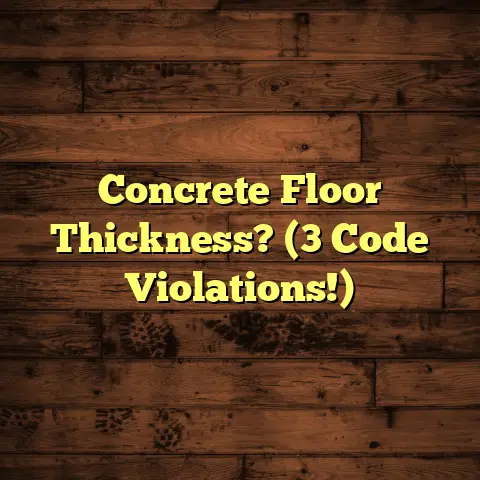How To Raise A Garage Floor? (7 Costly Errors!)
(7 Costly Errors!)
Let me tell you a story. It’s about my own garage, and let’s just say, it wasn’t always the envy of the neighborhood.
I remember the frustration vividly. Every spring, it was the same old story: a mini-lake forming in my garage. You know, thanks to the lovely (not!) combination of melting snow and poor drainage.
It wasn’t just the water, though. The floor was uneven, cracked, and frankly, an eyesore. Trying to organize anything in there was like playing a game of Tetris with wobbly blocks.
I’d had enough. I decided it was time to raise the garage floor. Sounds simple, right? Wrong! I dove in headfirst, thinking I could DIY my way to a perfect garage.
Big mistake. Huge.
I made so many blunders that could have been avoided with a little bit of knowledge. That’s why I’m writing this for you today.
I don’t want you to repeat my errors. In this article, I’m going to walk you through the seven most costly mistakes I made (and see others make) when raising a garage floor, so you can avoid the same headaches and heartaches.
Section 1: Understanding the Need to Raise a Garage Floor
So, why even bother raising a garage floor? Well, there are a few key reasons.
-
Flooding: Like my own personal nightmare, flooding is a major motivator. A raised floor can keep your belongings dry and prevent water damage.
-
Uneven Surfaces: Cracks, slopes, and general unevenness can make your garage unusable for many purposes. Raising the floor allows you to create a level, functional surface.
-
Creating Additional Storage Space: Sometimes, you might want to raise the floor to create a small step up to your house, or even create a small ramp.
-
Aesthetics: Let’s be honest, a cracked, stained garage floor isn’t exactly a selling point. Raising the floor can significantly improve the look and feel of your entire property.
What are the benefits of tackling this project? Think about:
- Enhanced Functionality: A level, dry garage is actually usable space!
- Improved Aesthetics: A clean, modern garage boosts curb appeal.
- Increased Property Value: A well-maintained garage is a huge plus for potential buyers.
But before you get too excited, let’s talk about the pitfalls. The main focus of this article is to help you avoid the common and costly errors that can turn your garage renovation into a disaster. Trust me, I’ve been there.
Section 2: Costly Error #1 – Skipping Proper Planning
Okay, let’s get real. Planning isn’t the most exciting part of any project, but trust me, it’s the foundation for success. Skipping this step is like building a house on sand.
One of the biggest oversights I see is homeowners not accurately measuring the area. You need precise measurements to calculate material needs and ensure everything fits properly.
Think about it: if you’re off by even a few inches, you could end up with wasted materials, gaps, or having to redo entire sections. I know someone who ordered too little concrete. The second batch didn’t match the first, and the whole floor looked patchy.
Another crucial aspect of planning is understanding local building codes. These codes exist for a reason – to ensure safety and compliance. Ignoring them can lead to fines, delays, and even having to tear down your work.
I was so eager to get started that I didn’t check the local regulations regarding floor height and drainage. Turns out, I needed a permit and had to make some costly adjustments to meet the requirements.
Real-Life Consequences:
- Wasted Materials: Incorrect measurements lead to buying too much or too little material.
- Increased Labor Costs: Mistakes during installation mean more time and money spent on fixing them.
- Project Delays: Discovering code violations mid-project can bring everything to a screeching halt.
Before you even think about picking up a shovel, take the time to create a detailed plan. Measure everything twice, research local codes, and sketch out your design. Trust me, your future self will thank you.
Section 3: Costly Error #2 – Ignoring Drainage Issues
Alright, let’s dive into something that’s near and dear to my heart (and my formerly flooded garage): drainage.
Failing to address drainage issues when raising a garage floor is like inviting disaster to your doorstep.
I’ve seen so many homeowners raise their garage floors, only to find themselves dealing with even worse flooding problems afterward. Why? Because they didn’t think about where the water would go.
Raising the floor without proper drainage can actually create a dam, trapping water against your foundation. This can lead to water damage, mold growth, and even structural problems.
One of my clients learned this the hard way. They raised their garage floor to create a workshop, but didn’t install any drainage. The next heavy rain turned their new workshop into a swimming pool. The cost of repairing the water damage and installing proper drainage was more than the original floor raising project!
Proper grading is essential for directing water away from your garage. The ground should slope away from the foundation, allowing water to flow freely.
You might also need to install a drainage system, such as a French drain or a sump pump, to handle excess water. A French drain is a trench filled with gravel and a perforated pipe that collects water and redirects it away from your property. A sump pump is a device that sits in a pit and pumps water out of your garage.
I wish I had known about these things before I raised my garage floor. I ended up spending a fortune on waterproofing and drainage solutions after the fact.
Key Takeaways:
- Ensure proper grading to direct water away from the foundation.
- Consider installing a French drain or sump pump to manage excess water.
- Don’t underestimate the importance of waterproofing the foundation.
Don’t make the same mistake I did. Take the time to assess your drainage situation and implement solutions before you raise your garage floor. It will save you a lot of headaches (and money) in the long run.
Section 4: Costly Error #3 – Using the Wrong Materials
Okay, let’s talk materials. Choosing the right materials for raising your garage floor is crucial for durability, longevity, and overall success.
I know it’s tempting to cut corners and go for the cheapest options, but trust me, it’s a false economy.
I’ve seen homeowners use low-quality materials that seem cost-effective upfront, only to regret it later when they start experiencing damage or needing repairs.
I once worked on a project where the homeowner used cheap concrete for the floor. Within a year, it started cracking and crumbling. They ended up having to tear it all out and start over with higher-quality concrete. The cost of the do-over was significantly more than the original project would have been if they had used the right materials from the start.
So, what are the right materials?
-
Concrete: High-strength concrete is essential for a durable garage floor. Make sure to choose a mix that is appropriate for your climate and usage.
-
Gravel: A gravel base provides a stable foundation for the concrete. It helps with drainage and prevents the concrete from cracking due to soil movement.
-
Rebar or Wire Mesh: Reinforcing the concrete with rebar or wire mesh adds strength and prevents cracking.
-
Waterproofing Membrane: A waterproofing membrane protects the concrete from moisture damage.
I personally recommend spending a little extra on high-quality materials. It’s an investment that will pay off in the long run.
Anecdotes:
-
I had a client who used cheap gravel for the base of their garage floor. The gravel wasn’t properly compacted, and the floor ended up sinking in several places.
-
Another client tried to save money by skipping the rebar. The floor cracked within months, and they had to spend a fortune on repairs.
Don’t be penny-wise and pound-foolish. Choose the right materials for your garage floor, and you’ll be much happier with the results.
Section 5: Costly Error #4 – Neglecting Structural Integrity
Raising a garage floor isn’t just about pouring concrete. It can significantly impact the overall structure of your home.
Neglecting structural support can lead to compromised walls, ceilings, and even the entire foundation.
I’ve seen cases where homeowners raised their garage floors without considering the load-bearing capacity of the walls. The added weight caused the walls to crack and bow, requiring extensive and costly repairs.
One of the biggest dangers is undermining the foundation. If you’re raising the floor significantly, you need to ensure that the foundation is properly supported. This may involve adding additional footings or reinforcing the existing foundation.
I once worked on a project where the homeowner raised the garage floor without consulting a structural engineer. The added weight caused the foundation to shift, resulting in cracks in the walls and ceilings throughout the house. The cost of repairing the structural damage was astronomical.
Examples of Costly Repairs:
- Cracked Walls: The added weight can cause walls to crack and bow.
- Compromised Ceilings: The ceiling can sag or even collapse if the walls are not properly supported.
- Foundation Issues: The foundation can shift or crack, leading to serious structural problems.
Before you start raising your garage floor, consult a structural engineer. They can assess the structural integrity of your garage and recommend the necessary support measures.
Don’t take shortcuts when it comes to structural integrity. It’s not worth the risk.
Section 6: Costly Error #5 – Underestimating Time and Labor Costs
Okay, let’s talk about the reality of DIY projects.
Many homeowners underestimate the time and labor involved in raising a garage floor. They think it’s a weekend project, but it often turns into a months-long saga.
I’ve seen DIY enthusiasts take on this project alone, only to face unexpected delays and complications. They run into problems they don’t know how to solve, and the project grinds to a halt.
One of the biggest mistakes is not accounting for the physical demands of the job. Moving concrete, digging trenches, and leveling surfaces is hard work. It can take a toll on your body, especially if you’re not used to it.
I remember when I tried to raise my garage floor by myself. I thought I could save money on labor costs. Big mistake! I ended up spending weeks working on it, and I was exhausted and sore the whole time. Plus, I made several mistakes that I had to fix, which ended up costing me more money in the long run.
Hiring professionals can save you money in the long run. They have the experience, tools, and expertise to get the job done quickly and correctly.
Benefits of Hiring Professionals:
- Expertise: Professionals know how to handle unexpected problems and ensure the job is done right.
- Efficiency: Professionals have the tools and equipment to get the job done quickly.
- Quality: Professionals guarantee their work, so you can be confident in the results.
Don’t underestimate the time and labor involved in raising a garage floor. Consider hiring professionals to save yourself time, money, and stress.
Section 7: Costly Error #6 – Failing to Account for Future Needs
When raising your garage floor, it’s important to think beyond the immediate project. Consider how you might use the space in the future.
Failing to account for future needs can lead to costly modifications down the line.
I’ve seen homeowners who raised their garage floors without thinking about future needs, only to regret it later when they wanted to install heavy equipment or create a workshop.
One of the biggest oversights is not planning for electrical outlets. If you plan to use your garage for woodworking or other power-tool-intensive activities, you’ll need plenty of outlets.
Another common mistake is not considering the height of the ceiling. If you plan to install a car lift or other tall equipment, you’ll need to ensure that the ceiling is high enough.
I had a client who raised their garage floor to create a home gym. They didn’t think about the height of the ceiling, and they couldn’t install the weightlifting equipment they wanted. They ended up having to lower the floor, which was a costly and time-consuming process.
Scenarios to Consider:
- Installing Heavy Equipment: Plan for reinforced flooring and adequate electrical outlets.
- Creating a Workshop: Consider ventilation, lighting, and storage space.
- Adding a Car Lift: Ensure sufficient ceiling height and structural support.
Don’t make the mistake of only thinking about the present. Take the time to consider your future needs and plan accordingly. It will save you a lot of hassle and expense in the long run.
Section 8: Costly Error #7 – Neglecting Finishing Touches
Okay, you’ve raised your garage floor. The hard part’s over, right? Not quite! The finishing touches are just as important as the foundation. Neglecting these aspects can lead to dissatisfaction with the final result or additional costs for upgrades.
Think about the flooring material. Are you going to leave it as bare concrete, or are you going to add epoxy, tiles, or some other type of finish?
I’ve seen homeowners neglect the finishing touches, only to be disappointed with the final result. They end up spending more money on upgrades later on.
One of the biggest mistakes is not properly sealing the concrete. Unsealed concrete is porous and can easily stain or crack. Sealing the concrete will protect it from damage and make it easier to clean.
Another common oversight is not insulating the floor. Insulating the floor can help regulate the temperature in your garage and make it more comfortable to use.
I once worked on a project where the homeowner neglected the finishing touches. They left the concrete unsealed, and it quickly became stained and cracked. They ended up having to spend a fortune on repairs and upgrades.
Finishing Touches to Consider:
- Flooring Material: Choose a durable and attractive flooring material that suits your needs.
- Sealing: Seal the concrete to protect it from damage and make it easier to clean.
- Insulation: Insulate the floor to regulate the temperature in your garage.
Don’t neglect the finishing touches. They can make a big difference in the overall look, feel, and functionality of your garage.
Conclusion: Summary of Key Takeaways
Alright, we’ve covered a lot of ground. Raising a garage floor can be a rewarding project, but it’s important to approach it with caution and forethought.
Let’s recap the seven costly errors to avoid:
- Skipping Proper Planning: Measure accurately, research local codes, and sketch out your design.
- Ignoring Drainage Issues: Ensure proper grading and install a drainage system if needed.
- Using the Wrong Materials: Choose high-quality concrete, gravel, and reinforcement.
- Neglecting Structural Integrity: Consult a structural engineer and reinforce the foundation if necessary.
- Underestimating Time and Labor Costs: Consider hiring professionals to save time and money.
- Failing to Account for Future Needs: Plan for electrical outlets, ceiling height, and other potential requirements.
- Neglecting Finishing Touches: Seal the concrete, insulate the floor, and choose a durable flooring material.
Remember my story? I learned these lessons the hard way. I don’t want you to make the same mistakes I did.
Take the time to plan carefully, choose the right materials, and pay attention to detail. It will ensure a successful outcome and a garage you can be proud of.
Call to Action:
Now, I want to hear from you! Have you ever raised a garage floor? What challenges did you face? What tips would you share with others?
Share your experiences and questions in the comments section below. Let’s learn from each other and create a community of informed and successful homeowners!





